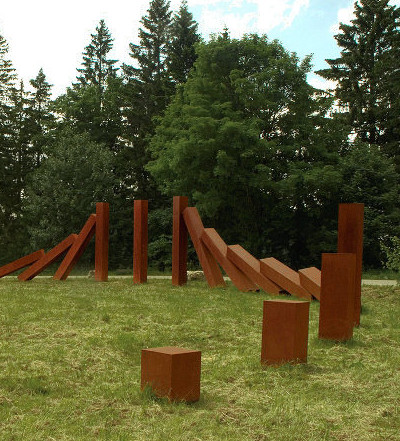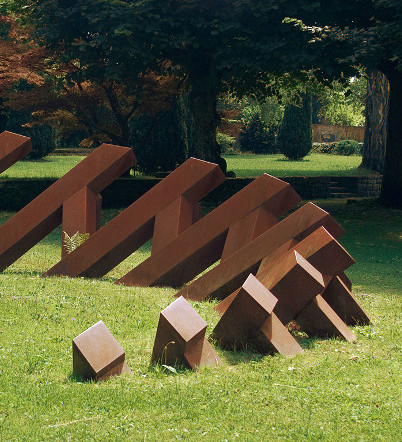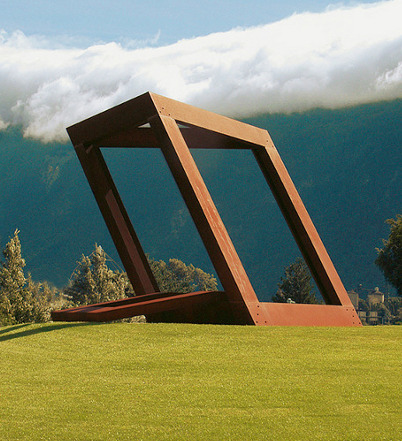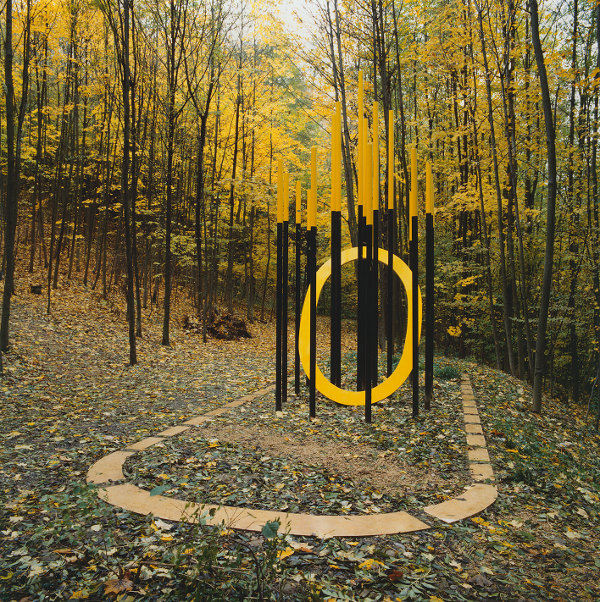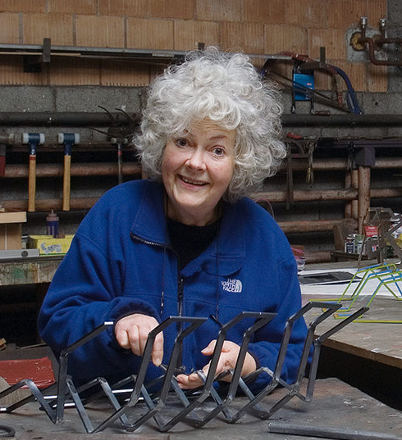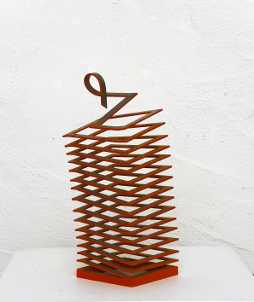By Sabine Altorfer
Whenever Gillian White is asked anything
about the concepts behind her art or its appearance, she tends to answer with gestures rather than words. She does not just use her hands and arms to delineate the waveforms of her compositions, or the staccato rhythm of particular elements, and often uses her whole body to emphasise its focal point. The Tanzende become not only three dimensional before the eyes of the listener, but the composition of a sculpture piece or the concept of a drawing is experienced as a rhythmic concept. It often seems as if the artist has choreographed her sculpture and paintings rather than composed them.
When Gillian White's work and life are considered this close relationship to dance and physical experssion becomes obvious. Before she became an artist, she attended a ballet school. A sense of rhythm and movement has clearly remained with her since crossing from one medium of art to another.
Although the material of steel is in reality so heavy, it appears light and full of movement. Gillian White works within a clear system, which like music produces a dynamic energy and tension through differing tempo and length of notes as well as variable tones, all within a predetermined system. Individual elements are allowed to change, to grow and shrink, turn, mirror one another or tip over and so a series of columns auch as The Winds with Wonder Whilst acquires energy and momentum. Moreover the steles are seldom arranged in straight lines; they stand in a cirle or a spiral. In additiona, the columns are not rectangular in cross section but rhomboid. this creates depth in perspective allowing the vanishing lines to run together, or apart, which further accentuates the dynamic effect. The lines of tension in these sculpture pieces seem to develop in all directions, we even imagine that they run into the earth. Moreover Gillian White likes to exaggerate or distort our experience of perspective: whatever is close appears large, and whatever is distant appears small.
If one examines the fundamental principles of Gillian White's sculpture, it becomes clear that she generally works with combinations and variations of individual elements. Isolated solo pieces are rare; she prefers to work with a corps de ballet or arrange at least a pas de deux. She will group the players in circles as in the Sphaeren (Spheres) or spirals as in Aufstieg (Ascent) or slanting rows as in several of her smaller sculpture pieces. At times it seems to be a game of ring-a-ring-a roses, at others an elegant classical ballet or even a refined deviations in the ascending and descending lines and the rhythmical increase of spaces between elements and angles.
Besides the analogy to dance, Gillian White's work insists on a comparison to the rhythms in nature: the swelling up and shrinking back, rising and falling, growing and withering in her work are in a way principles of nature. The columns or the flat backs of the Sphaeren (Spheres) can be interpreted as geological rejections or mountain ridges that, with varying strength, have grown out of the earth. With the arrangement and proportioning of columns according to the position of the sun Gillian White also established a cosmic system. Her later work can be seen as abstract translations of nature, whereas in her earlier work she remained closer to the sensual, natural world. For years she primarily reinterpreted waves and clouds.
The Gewaesserschutzplastik in Olten (sculpture piece commemorating water purification) reflects the movement of the waves in a austere and stylised manner. the columns of the Regenbogen-Wolken-Brunnen Rain Cloud Fountain) in Zifingen imitate soft drops of water. In Lief-Boat and WellenbrecherBreakwater) Gillian White for the first time develops the theme of interaction between the unbound power and dynamic energy of humans, technology and nature. The different sized feathers of the wing of the fallen Icarus appear to have grown. However, being close to nature is not what is important here rather the way that the delicate remains of this mythological figure have been arranged so that the momentum before the pitiless, terrible fall can still be felt.
Gillian White strives for harmony or conflict in her compositions, and also in the positioning of her sculpture pieces. She either adopts the curve of a stream or a slope or reverses it. Another time she uses the dark edge of a wood as the backdrop for her ballet, or emphasises the view into the distance across a lake, or into the mountains with a vanishing line. And even when, as in the case of Windjammer, she moves a sculpture piece from the peninsular at Au to mountainour Schändli above Meiringen and finally to the open Rhone valley, she manages to achieve a precise and illuminating relationship to the environment.
The place itself can contribute to the sculptural solution and even the colour scheme. For the Kulturweg (Cultural Path) Baden-Wettingen-Neuenhof Gillian White chose to position her piece in a clearing where the woodland was thinly forested. Slender, wound metal columns take on the form of the saplings, the yellow and dark violet paint appears to glow, to be eye catching in the greenish brown surroundings and also to accentuate the play of light, shade and pools of light.
Since the end of the eighties, although White has concentrated primarily on sculpture in her public commissions, she has continued to produce paintings, drawings and etchings in her private studio. With a group of friends she has also regularly drawn models. A series of swirling pointillist drawings from the end of the eighties, that are at the same time both dynamic and harmonious, testify to an exploration in circular and spiral forms that a little later become evident in her sculpture. She mounted airy, transparent, coloured circles on the windows of The British Coundcil in Prague that have a playful and celebratory effect. Also a slim circle of colour is suspended in the courtyard of the school at Dottikon.
For the first time at the end of the eighties Gillian White comined sculpture with painted surfaces into graceful pieces with the qualities of chamber mucic. Wave, White, Wedded, Words from 1988 places three-dimensional wave and bowlike forms against an evenly painted green and blue background. A little later the artist, while remaining a sculptor, transposed her desire to paint to creating three dimensional wall works. She mounted different sizes and layered paintings on wooden boards in Cortensteel frames. The proportions remind one of Concrete paintings, the treatment of the paint of Colourfield Painting and Art Informel. The heavy frames and in particular the empty spaces are the precise work of a sculptor: choice of colour, mixtures and combinations are those of a painter. It is never according to rules; intuitively Gillian White fixes the tone, combines and moreover builds up layers until a particular resonance and depth is created. The most remarkable feature of these three dimensional paintings is their celebratory effet. This is also proof of the artis'ts courage to explore the unknown including the dissonant colours she manages to combine to explosine effect.
With hindsight it seems as if the strict square or rectangular frames of the three dimensional picutres were too limiting for the creator of the Sphaeren and the Tanzende. So one day the coloured boards sprang out of their heavy Cortensteel frames and right angles. The Fliegende Bilder (Flying Pictures), and ensemble consisting of many parts, occupies whole walls with optimism and energy. Their glittering lightness reminds one of the earlier wall paintings of the artist but these ar airy and in general follow a colour theme. Their large gestures are insistent.
The small sculpture pieces combine to perfection rhythm, colour, three-dimensional form and colourful framing. During the last fefteen year, they have become the artis's hallmark. Sequence of spikes and indentations, of flanges and curves are arranged with a precise yet light hand; new forms and different effects constantly surprise. These miniature sculpture pieces are cut out of Cortensteel plates only a few millimetres thick then bent and welded into three-dimensional forms. Besides the rhythmic repetition of the wave like unwingding, or serial sequence, the interplay of surface and line is decisive. With pleasure Gillian White brings the opposition to a head by colouring the edges of the sculpture pieces transforming them into drawings in space. The eye follows these enticing narrow paths, the turns, the daring changes of direction and parallels. The colours have over time become ever more varied: green, blue, lilac, voilet, and all shares of red. However, the artis's favourite colour remains yellow, which in combination with the rust brown of the Cortensteel glows like sunshine.
The small sculpture pieces seem to synthesise different aspects and preoccupations of Gillian White's work. In contrast to the small-scale work of other sculpturs they are not conceived as models. Their rhythmic effects evoke the lightness and movement of dance; some even more. They react like accordions or feathers, rocking if delicately touched, or teetering in precarious balance over the edge of a table. The colourful edges appear to move in the curves of a kinetic experiment or like the rhythmic arm movements of a troop of modern dancers.
"Everything dances; that is in my nature", says Gillian White. Right. With their large gestures the paintings usurp rooms. In both the large and small pieces the sculptor, who once wanted to be a dancer, has not only overcome the weight of steel but also an inertia.
Sabine Altorfer
